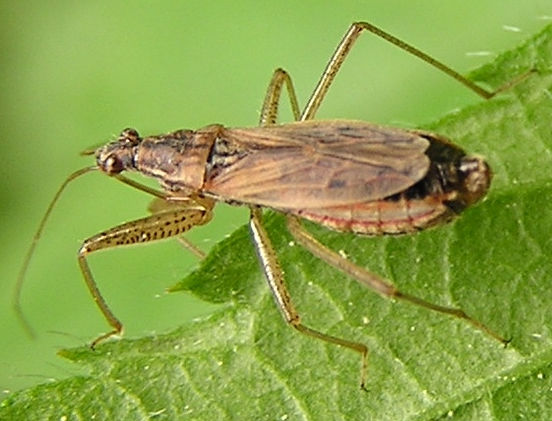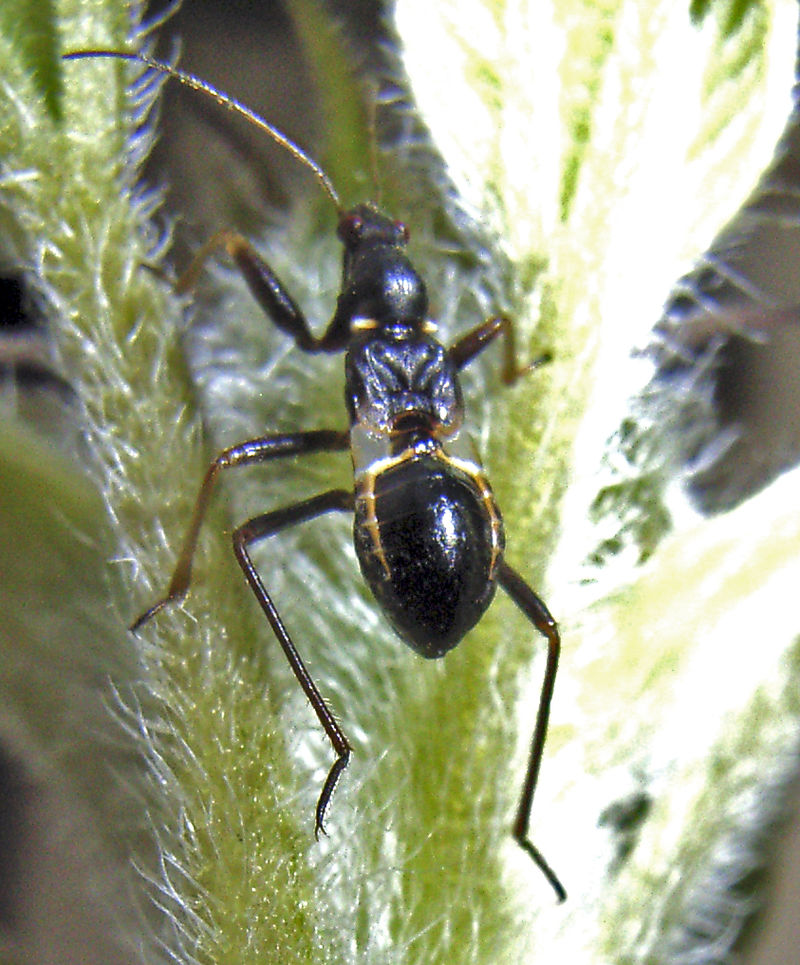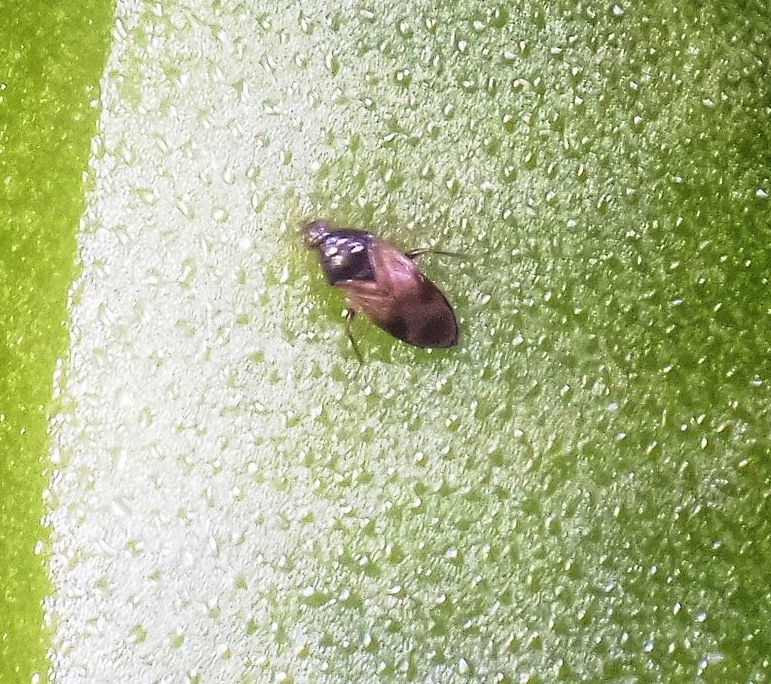- Home
- Garden Wildlife
- Insects
- Hemiptera
- Predatory land bugs
Predatory land bugs
Some bugs in the order Hemiptera use their sucking mouthparts to pierce the bodies of small insects and mites and suck out the contents. Some of the shieldbugs feed on other insects, but most of the predatory land bugs are in the families Nabidae and Anthocoridae. They are all very small, from 1.5 to 12mm long.
Species in Britain and Ireland
Bugs in the Nabidae are commonly known as damsel bugs. The adults often have shortened wings that do not fully cover the abdomen. Jennifer Owen found only the field damsel bug Nabis ferus. Species frequently found in gardens include the common damsel bug, Nabis rugosus, the tree damsel bug, Himacerus apterus, and the ant damsel bug, Himacerus mirmicoides. Immature nymphs of the last mentioned are good ant mimics.
Common damsel bug Nabis rugosus Tree damsel bug Himacerus apterus Ant damsel bug nymph Himacerus mirmicoides
Anthocorid bugs are sometimes called flower bugs, and they are very small, 1.5 to 5mm long, and notoriously hard to identify. Jennifer Owen encountered four species of Anthocoris of which the common flower bug Anthocoris nemorum was most abundant, followed by Anthocoris nemoralis. She also found Orius laevigatus and Orius vicinus.
Anthocoris nemoralis Orius laevigatus
Biology
Damsel bugs and flower bugs prey on a wide range of small insects and mites. They also use their sucking mouthparts to feed on insect eggs. Damsel bugs use their front legs to grab hold of their prey.
Life cycle
Eggs are laid on plants during the spring or summer. These hatch into smaller versions of the adult insect, gradually developing the adult features as they pass though the nymphal instars. Most species overwinter as adult insects in sheltered places but some overwinter as eggs.
Role of predatory land bugs in gardens
Predatory land bugs help to control some of the insects and mites that damage garden plants. These include aphids, leafhoppers, thrips and red spider mites. Orius laevigatus is sometimes used as a biological control to deal with thrips infestations in glasshouses.
Other sources of information
Website
Website of British Bugs - Nabidae
NatureSpot Nabidae
NatureSpot Anthocoridae
Book
Southwood, T. R.E. & Leston, D. (1959) Land and water bugs of the British Isles. Available as a CD-ROM or facsimile book from Pisces Conservation Ltd
Page drafted by Andrew Halstead, reviewed by Andrew Salisbury, edited by Steve Head

.jpg)

![Flower bug Anthocoris nemoralis Photo: Sarefo [CC BY-SA 4.0 (https://creativecommons.org/licenses/by-sa/4.0)]](images/Anthocoris.nemoralis.1.jpg)

Predatory land bugs
Some bugs in the order Hemiptera use their sucking mouthparts to pierce the bodies of small insects and mites and suck out the contents. Some of the shieldbugs feed on other insects, but most of the predatory land bugs are in the families Nabidae and Anthocoridae. They are all very small, from 1.5 to 12mm long.
Species in Britain and Ireland
Bugs in the Nabidae are commonly known as damsel bugs. The adults often have shortened wings that do not fully cover the abdomen. Jennifer Owen found only the field damsel bug Nabis ferus. Species frequently found in gardens include the common damsel bug, Nabis rugosus, the tree damsel bug, Himacerus apterus, and the ant damsel bug, Himacerus mirmicoides. Immature nymphs of the last mentioned species are good ant mimics.


.jpg)

![Flower bug Anthocoris nemoralis Photo: Sarefo [CC BY-SA 4.0 (https://creativecommons.org/licenses/by-sa/4.0)]](images/Anthocoris.nemoralis.1.jpg)
Anthocorid bugs are sometimes called flower bugs, and they are very small, 1.5 to 5mm long, and notoriously hard to identify. Jennifer Owen encountered four species of Anthocoris of which the common flower bug Anthocoris nemorum was most abundant, followed by Anthocoris nemoralis. She also found Orius laevigatus and Orius vicinus.
Top left: Common damsel bug Nabis rugosus
Top right: Tree damsel bug Himacerus apterus
Left: Nymph of ant damsel bug Himacerus mirmicoides
Anthocoris nemoralis Orius laevigatus
Biology
Damsel bugs and flower bugs prey on a wide range of small insects and mites. They also use their sucking mouthparts to feed on insect eggs. Damsel bugs use their front legs to grab hold of their prey.
Life cycle
Eggs are laid on plants during the spring or summer. These hatch into smaller versions of the adult insect, gradually developing the adult features as they pass though the nymphal instars. Most species overwinter as adult insects in sheltered places but some overwinter as eggs.
Role of predatory land bugs in gardens
Predatory land bugs help to control some of the insects and mites that damage garden plants. These include aphids, leafhoppers, thrips and red spider mites. Orius laevigatus is sometimes used as a biological control to deal with thrips infestations in glasshouses.
Other sources of information
Website
Website of British Bugs - Nabidae
NatureSpot Nabidae
NatureSpot Anthocoridae
Book
Southwood, T. R.E. & Leston, D. (1959) Land and water bugs of the British Isles. Available as a CD-ROM or facsimile book from Pisces Conservation Ltd
Page drafted by Andrew Halstead, reviewed by Andrew Salisbury, edited by Steve Head












